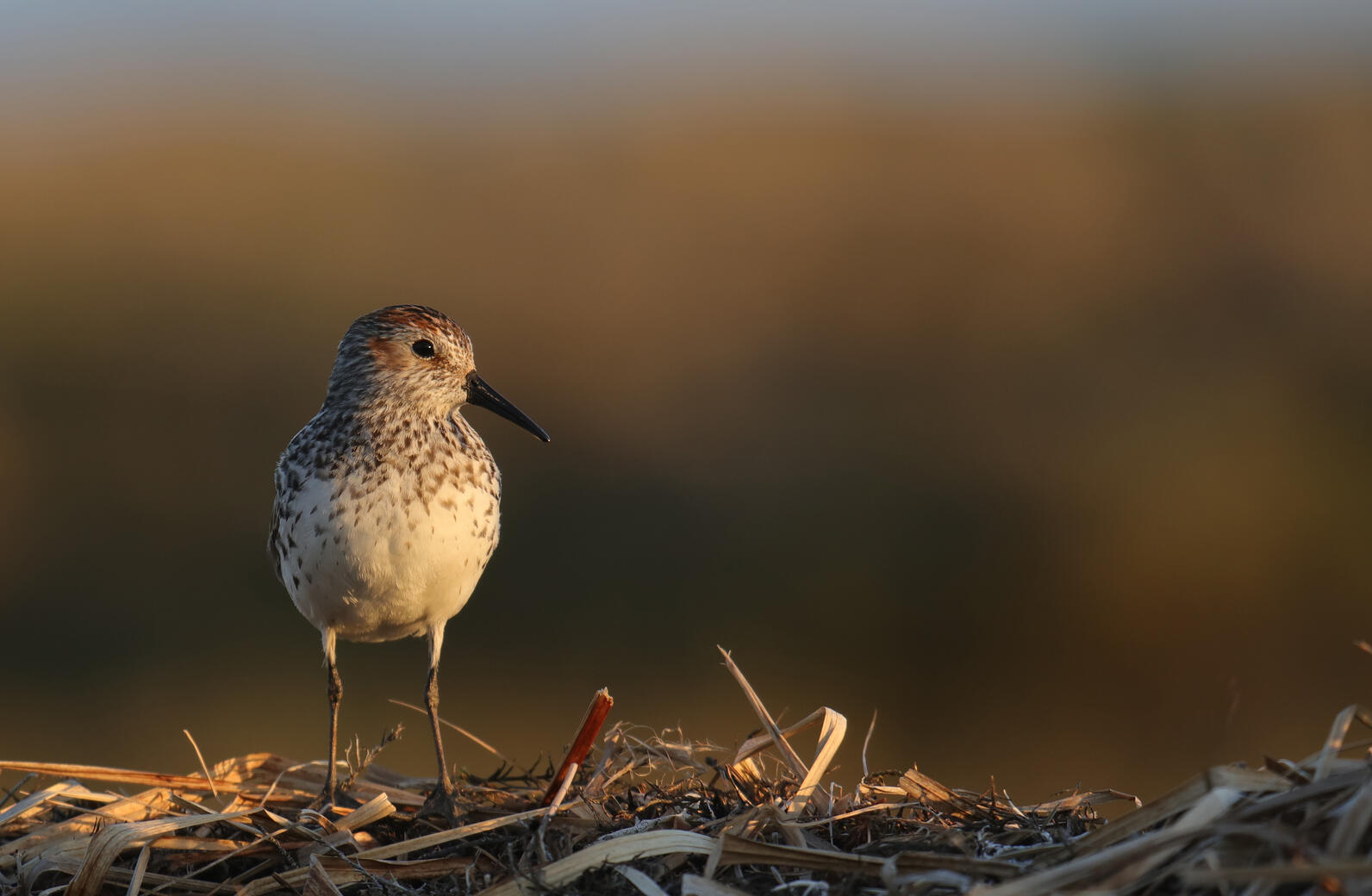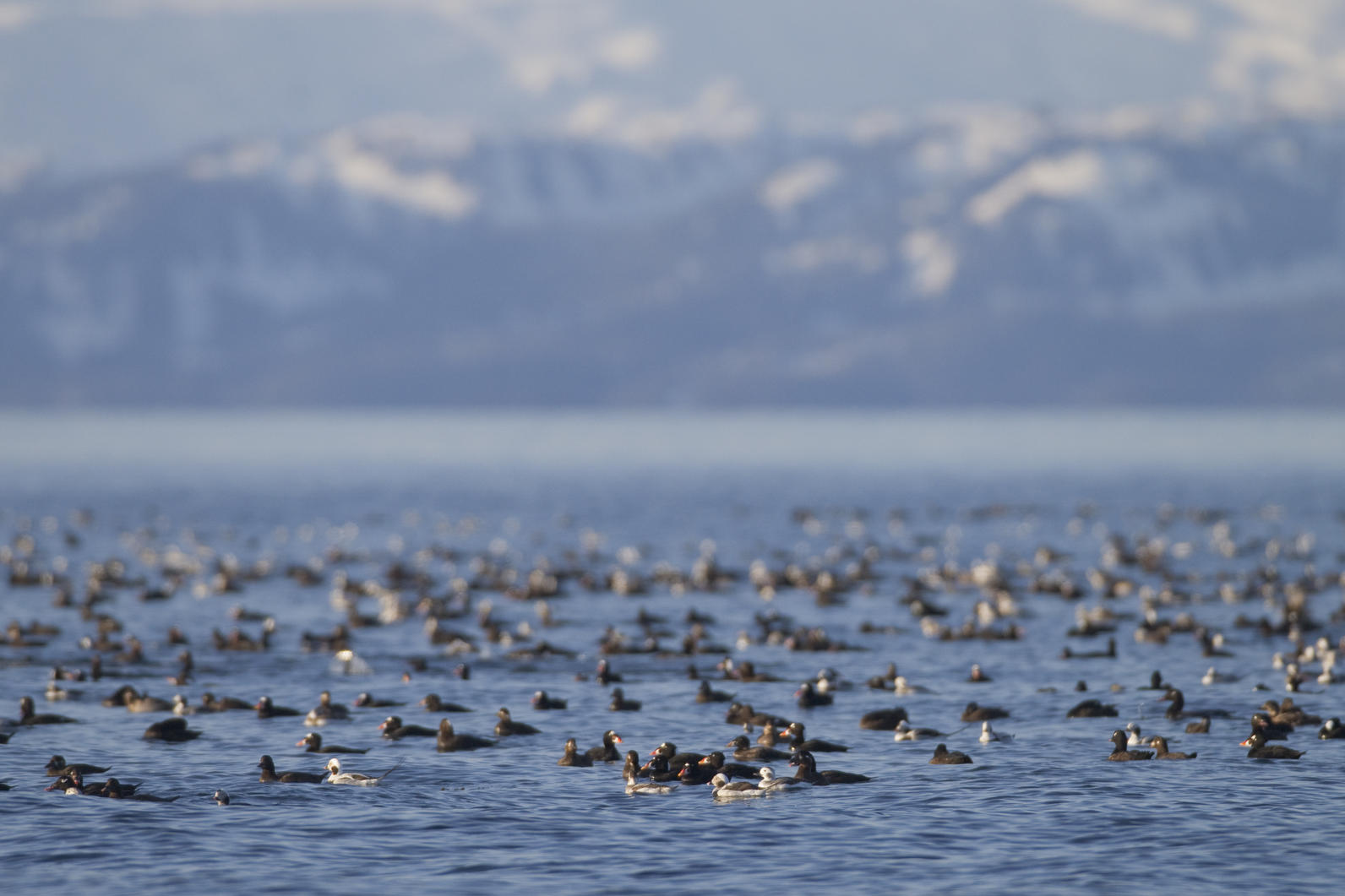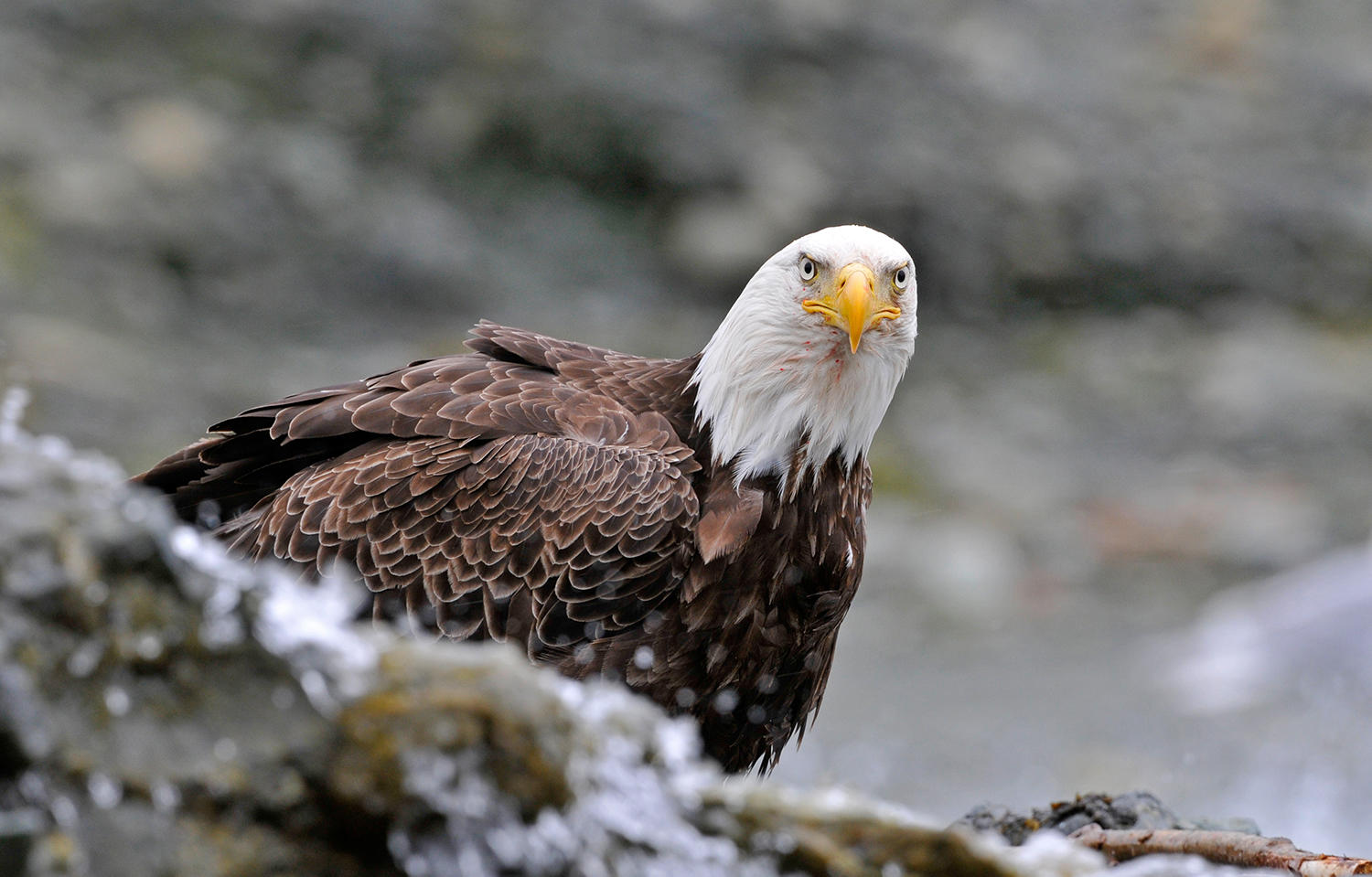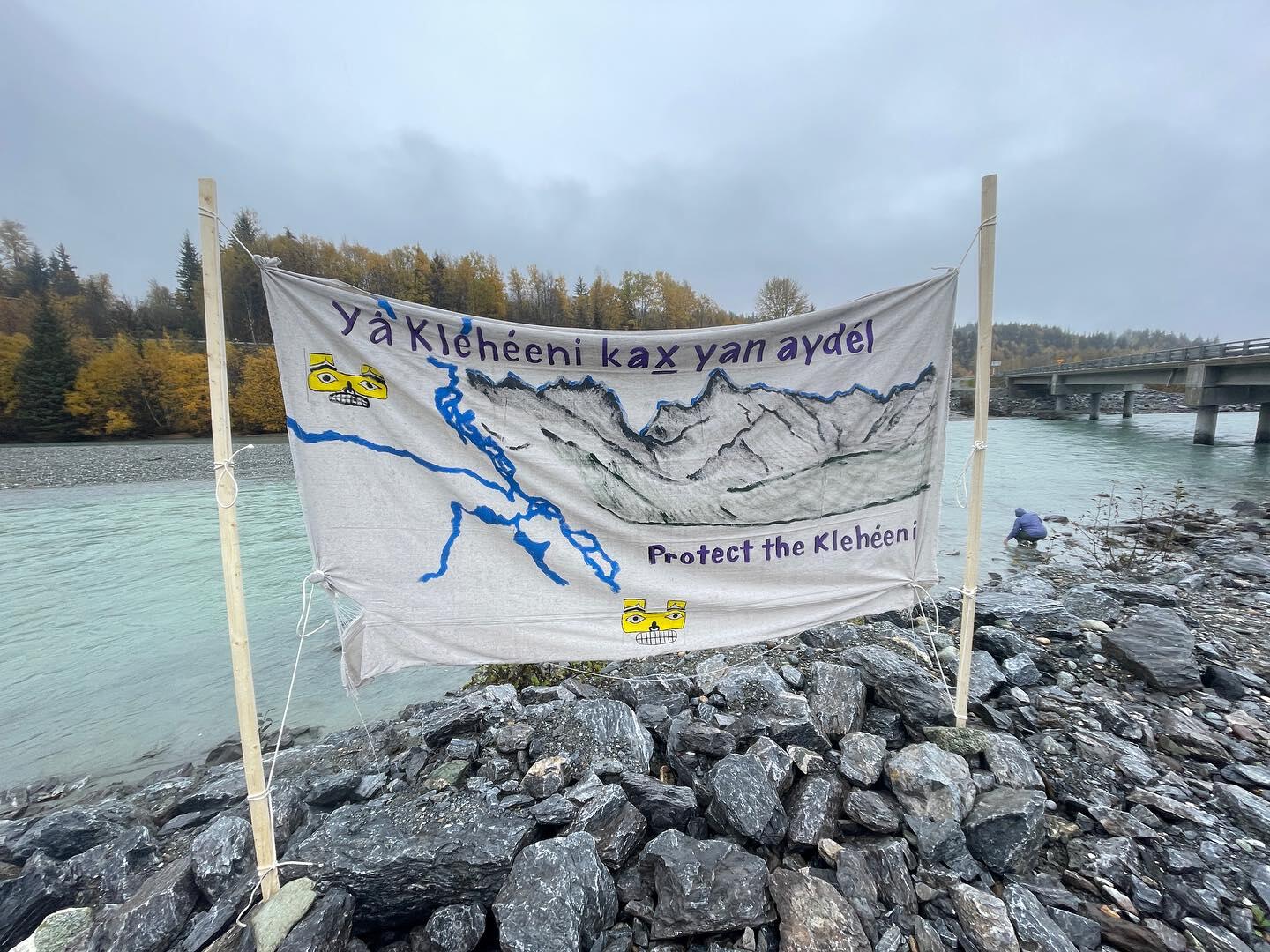Not many places on the planet look like Jilkáat Aani, or the Chilkat Valley. There are dramatic mountains, common in Southeast Alaska, the distinguished silty teal color of the waters, postcard communities, and life everywhere.
“We do have the jagged mountains, the Chilkat Range,” says Lani Strong Hotch, an award-winning textile artist and Chilkat Indian Village-proclaimed culture bearer. “I look out my window and I can see where part of the Tsirku enters into the Chilkat.”
The Chilkat Valley hosts the community of Deishú (Haines) and the Chilkat Indian Village (the Tribal government) of Klukwan, where Hotch is from, located at the confluence of the Tsirku, Klehini, and Chilkat rivers. And for a look at that “Chilkat blue,” Hotch says the geological story of the Tsirku is told through her Tsirku River Robe, a work she created using Chilkat and Ravenstail technique as the owner of Northwest Coast Textile Arts.
Within the Chilkat Valley sits the 49,000-acre Chilkat Bald Eagle Preserve Important Bird Area (IBA). It’s home to the world’s largest congregation of Bald Eagles, the annual Alaska Bald Eagle Festival, and the Jilkaat Kwaan Cultural Heritage Center and Bald Eagle Preserve Observatory. However, the Chilkat Watershed faces the threat of a proposed mine that has been steadily gaining ground.
While the region is known for its biodiversity, the National Audubon Society Science Division was recently able to put real numbers to anecdotal observation. They focused on migratory bird activity in the Chilkat Bald Eagle Preserve IBA, resulting in the aptly named “Importance of the Chilkat Bald Eagle IBA Region to Migratory Birds” report. In short, the Chilkat Valley is a major migration passage for many Alaska birds—particularly in fall and especially in spring.

On the Report
So, there wasn’t a ton of confidence going into this.
“It was the smallest area that we had run this analysis for,” says Bill DeLuca, Senior Manager of Migration Ecology at National Audubon Society. “I was a little worried.”
DeLuca is referring to the Migration Passage Analysis—a way to quantify just how important a site is for migratory birds. It uses “2022 eBird Status weekly estimates of abundance in conjunction with Partners In Flight population estimates to estimate the cumulative number of individuals and the percent of the total North American population passing through the study region during a migration season for each species included in the study,” or so the report reads. If you’re curious about the methodologies used to generate the Chilkat report, check out “The Colorado River Delta and California’s Central Valley are critical regions for many migrating North American landbirds” report.
In summer 2023, the Migration Passage Analysis was applied to the petite Chilkat Bald Eagle Preserve IBA, an area of approximately 18,100 hectares. For comparison, one of the first study areas, the Colorado River Delta, is 930,000 hectares.
All DeLuca was hoping to find in a borrowed pickup truck was “congregations of ≥1% of the global population of one or more species on a regular or predictable basis.” That means he was hoping the site would demonstrate greater than or equal to 1% of the total North American population of any bird species. That would prove the site to be of global significance. Yes, 1% sounds extremely low, but it’s actually pretty significant.
And how many species did they find hitting or surpassing 1%? 18. Not just one or two, but 18!
During spring migration, those species are Surf Scoter (18%), Glaucous-winged Gull (2%), Barrow’s Goldeneye (2%), Western Sandpiper (2%), and Bonaparte’s Gull (2%). Species that hit the 1% mark are Trumpeter Swan, Rock Sandpiper, White-winged Scoter, Varied Thrush, American Pipit, and of course Bald Eagle.
During fall migration, the study area sees Surf Scoter (9%), Glaucous-winged Gull (6%), Sharp-shinned Hawk (3%), and Bald Eagle (2%). Species hitting the 1% mark are Trumpeter Swan, Bonaparte’s Gull, Horned Grebe, Northern Goshawk, Dunlin, Golden Eagle, Harlequin Duck, and American Wigeon.
“I was more than half expecting not to find anything to cross that 1% threshold,” DeLuca says. “The fact that we had as many as we did cross that 1% threshold, that alone surprised me.”
And DeLuca says these estimates are probably on the lower end. There could well be more.
This news is welcome but probably not surprising to Stacie Evans, Science Director at Takshanuk Watershed Council (TWC) and board president at Lynn Canal Conservation, who’s lived in Haines since 2012. Before TWC, she studied seabirds in some of Alaska’s most remote places for six years with the U.S. Fish and Wildlife Service.
“The mouth of the Chilkat River provides crucial habitat for birds migrating to northern interior regions via the Shakwak Trench. Here there is a rich and expansive estuary where birds are able to take advantage of the last available marine resources, such as invertebrates and fish, before the long and arduous journey to their breeding grounds,” Evans says. “Without this final boost in calories, it is conceivable that this migratory route would not be viable.”

On Specific Species
Let’s start with the obvious winner of the Migration Passage Analysis, the Surf Scoter. To reiterate, the Chilkat Bald Eagle Preserve IBA sees 18% of the total North American population of Surf Scoter during spring migration and 9% in fall.
These ducks—the males black with a striking pattern of white head patches—migrate in flocks and are well known for the “rafts” that hundreds to thousands of Scoters (including White-winged Scoter, which hits the 1% threshold in the Chilkat region in spring) create on the water’s surface.
Hotch can confirm. “Oh yeah, you can get huge rafts of Scoters around here,” she says.
Evans agrees. “While learning that up to 18% of the North American population of Surf Scoters occurs here in the spring is not really surprising to me (I’ve witnessed the massive rafts), I am very excited that we now have the numbers to reinforce our anecdotal observations,” she says. “This means that we can better advocate for the protection of habitats that support these populations.” (Protections from what? More on that later.)
But DeLuca was pretty surprised to see that high of a number for Surf Scoters.
“It’s not like it’s 18% of a population that’s just really confined to Alaska; this is a continentally distributed species,” he says. “There are a couple [of species] that always stick out, and that was definitely one that stuck out for us.” (DeLuca says the population percentage of Sharp-shinned Hawk, 3% during fall migration, also surprised him.)
Other impressive numbers come from shorebirds like Dunlin and Western Sandpiper—rusty-colored little peeps that migrate in a series of short to moderate flights.
“One figure that is somewhat surprising to me, however, is that up to 2% of Western Sandpipers occur in the study area,” says Evans. “Western Sandpipers are a particularly vulnerable species because the vast majority stopover in [the Copper River Delta] during spring migration. If something were to happen there to make it unsuitable habitat for sandpipers, places like the Chilkat River estuary could become the last lifeline for the species.”
Then there’s the Horned Grebe, a small duck-like diver species that in its summer plumage has buffy-gold “horns” on its black head. Again, DeLuca clocked it at 1% during fall migration. And Audubon considers its conservation status as “vulnerable.” It’s thought to have declined in recent decades, although solid data is mostly lacking. (For interactive maps depicting the Horned Grebe’s migration and conservation threats, see Audubon’s Bird Migration Explorer tool.)
“Our job was to show for which species is that site important, and the Horned Grebe definitely shows up there,” DeLuca says. “If we’re saying that 2% of their whole population is going through Haines … that kind of means a big proportion of the ones that are breeding in Alaska are probably going through the Chilkat.”

On the Study Area
The Chilkat Bald Eagle Preserve IBA stretches along the Jilkaat Heeni, or Chilkat River, which means “Storage Container for Salmon” in Tlingit. It sits about 19 miles north on Haines Highway from Haines, 18 miles south of the Canadian border, and surrounds the Chilkat Indian Village of Klukwan—taken from the Tlingit phrase “Tlakw Aan” which means “Eternal Village,” or “The Village That Has Always Been.” The village is one of the longest continuously inhabited communities in North America.
“We don’t know exactly how long our people have been here, but I understand that there are some fish trap remains on the other side of the mountain that’s behind Klukwan on the Chilkoot River that was carbon dated to 2,000 years ago,” Hotch says. “And that shows the longevity of our people in this area.”
Hotch explains there are two moieties in Klukwan, the Raven and Eagle, which must be kept balanced. “In my household, my husband is the Raven. He’s the former clan leader for the Gaanaxteidi and I am Eagle from the Wolf House. So we have that balance in our home,” she says. “But now we’re matrilineal so all of our children are Kaagwaantaan—Eagle Wolf.”
Hotch says she and her husband, Chilkat Indian Village Vice President Jones P. Hotch, Jr., are “surrounded by Eagles here,” and that, “The Council Grounds are right around Klukwan.”
Council Grounds is another name for part of the Chilkat Bald Eagle Preserve, which was created in 1982 by the State of Alaska to protect Bald Eagles, salmon, and their essential habitats “in perpetuity.” And Audubon played a prominent role in its formation.
In fact, one of Audubon Alaska’s first actions as a then-regional office for Hawaii and Alaska was to help establish the Chilkat Bald Eagle Preserve. According to a 1984 coffee table book from Alaska Geographic titled “The Chilkat River Valley,” National Audubon Society in 1979 “initiated a four-year study in conjunction with the U.S. Fish and Wildlife Service to learn how the eagle could be protected while other resources were developed. Audubon sent Erv Boeker, a retired Fish and Wildlife biologist, to Haines to head the research.” That summer, former governor Jay Hammond signed into law a bill establishing the preserve. The Haines State Forest and the Chilkat Bald Eagle Preserve Advisory Council were also established.
The area was recognized as a state-priority level IBA, one of nearly 200 in Alaska, in 2008 based on the large number of Bald Eagles in the fall and nesting Trumpeter Swans in the summer. The Chilkat Bald Eagle Preserve IBA, plus Kluwan and Haines, are stops along the Southeast Alaska Birding Trail. And if you visit, the Jilkaat Kwaan Cultural Heritage Center and Bald Eagle Preserve Visitor Center is a great place to start.
But why do Bald Eagles, up to 4,000, gather here each fall?
“At the confluence of the Chilkat and Tsirku rivers warm groundwater discharges upward into the Chilkat River at about 40° F, protecting sections of the river from freezup,” reads “The Chilkat River Valley,” from Alaska Geographic. “Open water supports the later salmon run, which in turn provides plentiful meals for eagles during an otherwise lean time of year.”
So the area is known for Bald Eagles and, as we’ve proven, tons of other birds, but that’s just a fraction of what occurs here.
“The Chilkat Valley is one of the most biodiverse places in Alaska,” Hotch says. “We live amongst all these birds and animals and they’re part of our daily life. We respect them and appreciate them, and they add to our life experience and quality of life.”
If you really want to dig, check out the Ecological Atlas of Southeast Alaska, an Audubon Alaska publication from 2016. But to zoom in on the Chilkat region, there’s saak (or eulachon, a type of smelt), trout, char, and all five species of Pacific salmon. There are black and brown bears and the most genetically diverse mountain goat population in North America. Then add moose, wolves, lynx, orcas, sea lions, on and on. Plus tons of flora—like the rare mountain lady’s slipper—in addition to all that fauna. There’s also hemlock, spruce, paper birch, and giant black cottonwood trees as well as multitudes of berries.
“We often talk about biodiversity in the Chilkat Valley, and for good reason,” Evans says. “The valley hosts the most mammal species in Alaska (we’re up to 39 after a fisher was trapped here last winter), the most bird species detected in Alaska during the annual United States Geological Survey Breeding Bird Survey, and the most vascular plant species found in Alaska.”
And right now in spring, this is all very apparent. Especially with this year’s eulachon run.
“It feels very timely to comment on avian communities in the Chilkat Valley right now. With indeterminable numbers of gulls (I’ve been marking more than 100,000 on my datasheet, but I’m certain it is far more than that), thousands of ducks, and hundreds of eagles, all gorging themselves on eulachon and their eggs, it’s impossible not to be impressed by the biomass generated by this phenomenon,” Evans says. “There are fish everywhere right now, and not just along the river. Birds—ravens in particular—are constantly dropping eulachon in the forest, demonstrating their role as natural fertilizers.”

On Threats Against (and Wins for) the Chilkat
Looking at the report, at the data showcasing significant populations for multiple bird species, Deluca says, “I’d be really worried about doing anything that affects the watershed there.”
He’s not alone.
Upon its 1982 establishment, the Chilkat Bald Eagle Preserve was to be closed “to mineral entry, commercial timber harvest, and sale of land under the state land disposal program,” reads “The Chilkat River Valley.” However, there isn’t protection for the entirety of the Chilkat and its watershed.
For years, the threat to Chilkat water quality was logging. “Haines does not see as much logging as it used to,” says Evans. “But logging affects the temperature of the water, which affects the salmon, and everything around here depends on salmon.”
But the threat now is the proposed Palmer Mine.
The currently known Palmer Project is a proposed mixed metals mine that would be set at the headwaters of the Chilkat Watershed. The ore body is located beneath land managed by the Alaska Mental Health Trust and the Bureau of Land Management (BLM). The two mining operations are Constantine, a subsidiary of the Canadian company American Pacific Mining, and DOWA, a Japanese smelter company. There has been drilling, blasting, seismic testing, and infrastructure development. The end goal is a mining district for zinc, copper, silver, gold, and barite above the Klehini River, a major tributary of the Chilkat River (and both were named among America’s Most Endangered Rivers of 2023).
All this has led some conservationists in the Chilkat Valley to call Palmer the new Pebble Mine. And why?
Shannon Donahue—Executive Director of Great Bear Foundation who also runs Arcturus Conservation Consulting—can break it down. She’s been combatting the project for years. But in short, it is incredibly risky to develop on the ore part of a volcanogenic mass sulfide deposit because of its acid-generating rock.
“When exposed to air and water, this rock undergoes a chemical reaction producing a substance similar to battery acid that usually leaches into nearby waters,” Donahue explains. “This Acid Rock Drainage (ARD) typically requires active water treatment for perpetuity, often for centuries—long after mining companies have come and gone.”
Donahue says ARD and heavy metals associated with mining have toxic effects on wildlife and people. ARD acidifies streams and groundwater and dissolves rock to release additional metals into water. What’s more, copper can interfere with the ability of salmon to locate home spawning streams and selenium can cause spinal deformities in fish. This is no good, as “the ecology, economy, and cultures of the Chilkat Watershed revolve around healthy salmon runs.”
Hotch can speak to that culture part.
“In Klukwan, we eat that salmon in the river and have for countless generations. That’s what brought our people here to begin with,” she says. “It’s not just our livelihood, but our whole cultural way of living is at stake here. Not just what we put in our mouths, but our way of life here.”
Of course, a major push for the Palmer Mine has to do with the supposed economic benefits the operation could bring. But Hotch, and many others, say that would be short-lived. Donahue shares that an independent analysis by mining expert Jim Kuipers found the mine’s preliminary economic assessment (PEA) overestimates mineral prices and underestimates the project’s costs, making the Palmer Project highly speculative, with a high level of risk. Plus Constantine-American Pacific Mining has stated the life of the proposed mine to be just 10 to 15 years.
“We try to wake people up to the fact that this river is a treasure, with untold treasures,” Hotch says, “and we shouldn’t risk it for a quick shot in the arm economically.”
If you’re curious about the legality of all this, it’s on the level. Mining in the U.S. is governed by the Mining Law of 1872 (which sounds dated because it is). “And, the Palmer Project is still operating under an outdated surface exploration plan approved by the BLM that fails to account for impacts of underground exploration,” Donahue explains. “State regulations are also weak. The state has permitted the project to discharge wastewater into groundwater where it will likely end up in the Klehini and Chilkat rivers, ignoring the need for a Clean Water Act permit for discharge to surface waters.”
Then there’s the tunnel.
Constantine-American Pacific Mining plans to dig a 1.25-mile tunnel at the headwaters of Glacier Creek beneath Saksaia Glacier for exploration—which, though exploratory, can still have irreversible impacts. “This is a point-of-no-return,” Donahue says, “because once the tunnel hits acid-generating rock, the tunnel is likely to leach ARD and heavy metals into the surrounding environment—a process that is extremely difficult if not impossible to stop.”
And there are new developments all the time. Here’s a quick look at just some of the action of the past year:
- In spring 2023, Constantine-American Pacific Mining’s application to mine at the Chilkat Watershed headwaters in the Glacier Creek Valley failed to provide adequate information about baseline conditions and potential impacts on birds, fish, other wildlife, and water quality (there was a short comment period for this, during which we saw 13,669 individual Audubon action takers in about a week).
- Last fall, Earthjustice had to file an appeal in the Alaska Superior Court on behalf of Lynn Canal Conservation, Rivers Without Borders, and the Southeast Alaska Conservation Council for more protective standards for wastewater discharge from mineral exploration conducted by Constantine-American Pacific Mining.
- This winter, Gov. Mike Dunleavy issued Executive Order No. 132 to eliminate the Alaska Chilkat Bald Eagle Preserve Advisory Council—the aforementioned committee that applies local and Indigenous knowledge toward managing the Chilkat Bald Eagle Preserve IBA. Its duties would have been taken over by the Alaska Department of Natural Resources (DNR) but the Alaska Legislature rejected this in March.
- And just this spring, Constantine-American Pacific Mining released a 336-page document outlining the Palmer Project’s five-year Plan of Operations (literally PoO). DNR allotted just two weeks for public review and input despite official calls to extend this comment period (which didn’t happen).
Groups dedicated to combatting the proposed Palmer Mine have made headway, though. Chilkat Indian Village has been challenging permits and approvals for the Palmer Project since 2017. For many groups, a big win came in 2019 when Constantine-American Pacific Mining applied for a State of Alaska Waste Management Permit to discharge wastewater into the ground near the headwaters of Glacier Creek and the Alaska Department of Environmental Conservation remanded the permit for informal review in response to requests from Tribes and conservation organizations.
There have been little victories and setbacks over the years, but last fall, the people of Jilkáat Aani turned out in person for what turned out to be an eventful week.
On October 2, 2023, more than 150 Klukwan and Haines residents gathered to oppose the Palmer Project in Haines. Then on October 5, another 100-plus community members and visitors came together at a bridge at the 26-mile mark of Haines Highway for a water blessing ceremony, again to voice their opposition to the proposed Palmer Mine.
“It was very gratifying to see the number of people who turned out to our water blessing ceremony—and it was pouring rain that day!” Hotch says. “My regalia was all soaking wet. I had to spread it out in my big room and let it air dry for a couple of days.”
At the ceremony, Hotch says the crowd prayed, shared Klukwan founding stories, sang and played music, and, among other activities, wrote words of gratitude and blessings on pieces of driftwood and dropped them in the water. “Because words have power,” Hotch says. “We didn’t want to wait until they’re actually hauling ore out on trucks to make our voice be heard. We don’t want to wait till it’s too late.”
While the Palmer Mine would have a future impact on the Chilkat, it’s clearly taking a toll on its residents now. “We live with a certain amount of angst here because of that,” Hotch says. She says her husband Jones, who’s over 70, should be enjoying retirement instead of leading efforts on behalf of the Chilkat Indian Village to fight the Palmer Mine, but there’s too much at stake.
“We don’t want our life way of life to go down on our watch while we have life and breath in us,” she says. “We got to do what we can, we have a responsibility to future generations. So that’s what keeps us working on it.”









